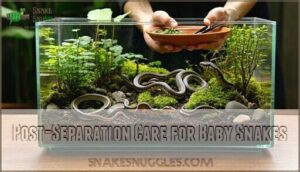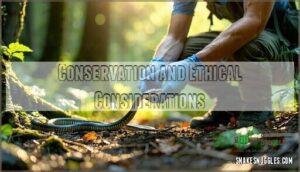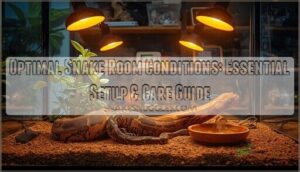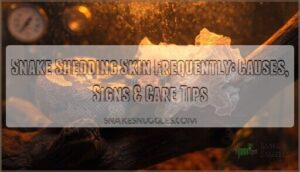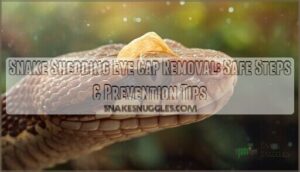This site is supported by our readers. We may earn a commission, at no cost to you, if you purchase through links.
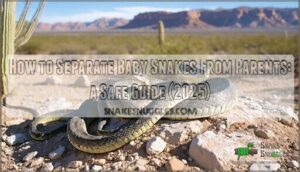
The trigger for this separation isn’t arbitrary: it’s written in chemical signals, hormonal shifts, and one universal marker that tells both mother and offspring it’s time to part ways.
If you’re working with species that exhibit maternal care, recognizing these biological cues means the difference between a smooth shift and unnecessary stress. Knowing when and how to step in requires understanding what nature already programmed into these snakes—and respecting the timeline their bodies follow.
Table Of Contents
Key Takeaways
- Rattlesnakes and pitvipers guard their babies for roughly four days after birth, with maternal care driven by vasotocin hormone levels that drop sharply once neonates complete their first shed—this biological trigger marks the natural separation point across nearly all 230 pitviper species studied.
- The first shedding cycle (typically 7-14 days post-birth) serves as nature’s universal separation cue, signaling that baby snakes have reached functional independence with survival rates jumping to 77% when maternal attendance is present through this critical window.
- Successful separation requires precise timing and setup: wait for the completed first shed, use snake hooks for handling venomous species, and provide each neonate with a 10-20 gallon enclosure featuring thermal gradients (75-85°F), 50-60% humidity, and snug hiding spots on both warm and cool sides.
- Baby snakes won’t eat immediately after separation—expect a 5-14 day fast post-shed before offering pre-killed prey every 5-7 days, and watch for independence markers like active exploration, defensive tongue-flicking, and clear eyes to confirm they’re thriving solo.
Snake Parenting: How and When Separation Occurs
Most snakes won’t win any parenting awards—they usually lay eggs or give birth, then leave their young to figure things out alone.
But a few species break the mold, sticking around to guard their babies until nature signals it’s time to part ways.
Understanding how and when this separation happens is key if you’re working with snakes that actually care for their young.
Typical Parenting Behaviors in Snakes
Most snakes won’t win any "Parent of the Year" awards—they usually lay their eggs or drop their live young and head off without so much as a backward glance. This hands-off approach isn’t neglect; it’s just reptile parenting in action.
Most species lack the maternal instincts you’d see in mammals or birds, and snake social bonds are virtually nonexistent in the wild habitat. In herpetology and zoology, this behavior makes perfect sense—their young are born ready to survive independently, no family reunion required.
Species Known for Maternal Care (e.g., Rattlesnakes, Pitvipers)
But here’s where reptile parenting gets interesting—rattlesnakes and pitvipers break the mold completely. Maternal care has been documented in at least 33 species across 12 genera of pitvipers, with mothers sticking around for roughly four days after birth. Over 70% of female Dusky Pigmy Rattlesnakes stay with their litters through the third morning, a behavior that’s rare in herpetology and viper conservation circles.
Rattlesnakes and pitvipers defy typical reptile parenting—mothers in 33 pitviper species guard newborns for days, with over 70% staying through the third morning
What makes rattlesnake behavior and parenting stand out:
- Protection mode activated: Mothers become noticeably more aggressive toward predators, sometimes even chasing off threats to their young.
- Built-in thermostat: Female rattlesnakes provide body heat to help neonates regulate temperature and complete their first shed.
- Survival boost: Studies show neonates with maternal attendance can hit survival rates up to 77% in their first year—pretty impressive for snake maternalism.
The unique rattlesnake family dynamics play a vital role in the development and survival of the young snakes.
Biological Cues for Mother-offspring Separation
So what actually triggers that maternal bond to break? It’s not random—Wildlife Biology shows that Hormone Triggers and Chemical Signals drive the whole process. Vasotocin, the same hormone seen in birds and mammals, controls Maternal Instinct in snakes. When vasotocin receptors are blocked, maternal attendance drops by over 60%.
At the same time, Neonate Development shifts dramatically during the Shedding Cycle—tongue-flicking rates spike as babies learn to recognize their environment. Rattlesnake Behavior and Parenting studies reveal that Animal Behavior and Ecology depends heavily on these chemical cues, which fade fast once neonates complete their first shed.
The role of vasotocin receptors is pivotal in understanding the disruption of maternal care in snakes.
The First Shed as a Separation Trigger
Once those hormonal signals fade, the first shed becomes the universal exit cue—across nearly all 230 pitviper species studied, mothers consistently abandon their young right after that initial skin comes off. Here’s what drives this Separation Cue in Rattlesnakes and other species:
- Hormonal Changes in vasotocin levels drop sharply post-shed
- Neonate Development reaches functional independence for hunting
- Maternal Instincts dissolve as chemical recognition fades
- Baby Rattlesnake tongue-flicking behavior peaks, signaling readiness
- Shedding Process completes within 7–14 days of birth
This Reptile Care and Management benchmark marks true independence in Animal Behavior and Ecology.
Preparing to Separate Baby Snakes Safely
You can’t just pull baby snakes away from their mother on a whim—timing matters, and so does technique.
Separation is a delicate process that requires recognizing the right developmental cues and managing both mother and offspring with care.
Here’s what you need to know before you make the move.
Identifying The Right Time for Separation
Timing is critical when separating baby snakes, and getting it wrong can spell trouble for both mother and offspring. Watch for the first shedding cycle—that’s nature’s green light. In pitvipers and baby rattlesnakes, maternal instinct fades once neonates shed their initial skin, signaling they’re ready for independence.
| Species Group | Separation Timing | Key Cue |
|---|---|---|
| Rattlesnakes | After first shed | Completed shedding cycle |
| Pitvipers | 7-14 days post-birth | Neonate development stage |
| Ball Pythons | Immediate (no parental care) | Birth itself |
| Water Pythons | 3-50+ days | Maternal investment ends |
This biological trigger reflects parental investment ending—rattlesnake removal experts and herpetology research consistently document this pattern in reptile care and management.
Recognizing Signs of Independence in Neonates
Baby snakes telegraph their readiness for solo life through a handful of unmistakable behaviors that signal it’s time to let them venture out on their own.
Watch for these clear indicators of neonate development:
- Active exploration beyond the maternal bonding zone—they’re slithering confidently away from mom
- Tongue-flicking and defensive posturing show neonatal behavior tied to independent hunting instincts
- Completed shedding cycle with clear eyes and intact shed skin
These zoology and herpetology markers reflect biological readiness in snake socialization and animal care practices.
Handling Precautions for Both Mother and Young
When you’re moving baby snakes away from their mother, your safety—and theirs—hinges on treating both parties like the defensive, stress-sensitive animals they are. Use snake hooks or tongs—never bare hands—especially with venomous care situations like rattlesnake removal.
Maternal bonding creates heightened defensiveness, so minimize handling stress during neonate manipulation. Snake catchers and wildlife and conservation professionals prioritize calm movements and proper snake safety protocols to protect both generations during this critical zoology and herpetology shift.
Tools and Materials Needed for Separation
You’ll need the right gear before you even think about reaching for that first baby snake—think of it as assembling your toolkit before surgery, except your patients have fangs and zero patience for improvisation.
Snake hooks and escape-proofing containers top the list—snake catchers managing rattlesnake removal rely on these daily.
Add heating elements, humidity controllers, and separation kits designed for wildlife conservation work. This biology-backed approach keeps everyone alive.
Setting Up Enclosures for Baby Snakes
Once you’ve got your baby snakes ready to go solo, they need their own space—and not just any container will do. Each neonate requires an enclosure that balances security with proper environmental controls.
Here’s what you need to set up for each individual snake.
Recommended Tank Sizes and Habitat Features
Setting up the right home for your newly separated baby snakes isn’t about luxury—it’s about survival. Getting the size wrong can mean the difference between a thriving neonate and one that refuses to eat or constantly tries to escape.
For most species like rattlesnakes, start with a 10-20 gallon snake enclosure—something cozy, not cavernous. Proper ventilation systems and humidity control matter more than square footage at this stage in their biology and ecology.
Temperature and Humidity Requirements
Think of temperature and humidity as the invisible blueprint your baby snakes rely on to digest food, shed properly, and stay alive—get either one wrong and you’re looking at regurgitation, stuck sheds, or worse.
For rattlesnakes, maintain thermal gradients between 75-85°F with a basking spot hitting 90°F. Humidity control sits at 50-60%, preventing respiratory issues while supporting environmental stability vital to their biology.
Safe Substrate and Hiding Spots
Your substrate choice can either support a stress-free first shed or trigger a medical emergency—paper towels and reptile bark work, while gravel and sand cause impaction or abrasions that baby snakes can’t afford.
You’ll need at least two hiding places per enclosure—one on the warm side, one on the cool—to let rattlesnakes thermoregulate without exposure stress. Snake hides should fit snugly; oversized shelters won’t provide the security contact neonates instinctively seek after separation.
Preventing Escape and Stress in Neonates
Even a perfectly designed hide and substrate won’t protect neonates if your enclosure has gaps wider than a quarter-inch—baby rattlesnakes can flatten their bodies and squeeze through openings you’d swear were too small. Escape prevention starts with a lockable lid and mesh finer than 1/8", because stress reduction depends on habitat design that keeps snakes secure.
- Check tank seams and ventilation screens weekly
- Use aquarium-grade silicone to seal any gaps
- Weighted lids prevent accidental openings during neonatal care
- Minimize contact for 5–7 days post-separation
Post-Separation Care for Baby Snakes
Once you’ve separated your baby snakes, the real work begins—keeping them thriving on their own. The first few weeks are critical for establishing routines around feeding, hydration, and health monitoring.
Let’s walk through the essentials you’ll need to cover during this vulnerable shift period.
Initial Feeding Schedules and Diet
Once your baby snake sheds for the first time—usually within 7 to 10 days after birth—it’s ready to eat, but don’t expect immediate results since most neonates wait another 5 to 14 days before taking their first meal.
Offer pre-killed prey items—commonly pinkie mice for rattlesnakes and smaller species—every 5 to 7 days initially. You’ll meet their nutrient requirements without overfeeding, and food variety isn’t necessary at this stage since rodents provide complete nutrition.
Monitoring Health and Behavior
After those first few meals, keeping a close eye on your neonate’s day-to-day condition helps you catch problems early—before they turn serious. Watch for clear eyes, smooth sheds, and active tongue-flicking—signs your snake’s developing normally. Lethargy, refusal to eat beyond two weeks, or cloudy discharge signals trouble.
Environmental factors like incorrect temps can trigger stress, so double-check your setup if behavioral cues seem off.
Hydration and Environmental Enrichment
Fresh water isn’t optional—it’s survival fuel—and a shallow dish placed in the coolest zone lets your neonate drink, soak, and regulate humidity all at once. Change water daily to maintain quality, and mist substrate lightly if humidity dips below 50%.
Add a climbing branch or safe hide for environmental stimulation—those thermal gradients and texture choices mirror wild conditions, keeping stress low and curiosity high.
Common Issues and Troubleshooting
Feeding refusal tops the trouble list—neonates commonly fast for two weeks post-separation, so wait seven days before offering food at 10% body weight.
Watch for stress signals like glass-striking or relentless pacing, which mean your enclosure size or hides need tweaking. Dehydration shows as sunken eyes; retained shed points to low humidity.
Respiratory issues or face swelling demand immediate vet attention—don’t wait.
Conservation and Ethical Considerations
When you’re working with baby snakes, whether you’re breeding them or managing them in the wild, there’s a bigger picture to keep in mind beyond the mechanics of separation. The choices you make affect not just individual animals, but entire populations and ecosystems.
Let’s look at the conservation and ethical principles that should guide your approach to snake management.
The Importance of Responsible Snake Management
Whether you’re breeding snakes at home or managing wild reptiles that wander onto your property, responsible management isn’t just about safety—it’s about respecting the biology and welfare of animals that have evolved over millions of years to survive without us. Here’s what ethical snake management looks like:
- Prioritize snake welfare over convenience in every separation decision
- Preserve natural habitat instead of forcing unnecessary relocations
- Contact professionals like SoCal Rattlesnake Removal for venomous species
- Apply proper snake management techniques learned from experts, not viral videos on Facebook
- Support venom research and conservation ethics through informed choices
Florida Gulf Coast University’s Environmental Science and Biology programs continue revealing how mother snakes invest months caring for neonates—knowledge that should shape how we intervene.
Supporting Reptile Conservation Efforts
Habitat Preservation and Wildlife Protection start with understanding that every snake encounter matters. When you support Conservation Funding through organizations like SoCal Rattlesnake Removal, you’re not just paying for safe relocations—you’re investing in Reptile Research that shapes Environmental Education.
Florida Gulf Coast University’s Environmental Science and Biology programs rely on donations to decode maternal behavior, data that spreads through Facebook and beyond viral videos.
The Role of Snake Removal and Relocation Teams
When a rattlesnake turns up on your porch or a python settles into your backyard shed, you’re not just dealing with an unwanted guest—you’re witnessing the frontline work that keeps both humans and snakes alive.
Wildlife Experts trained in Venomous Management use specialized Removal Techniques to relocate these animals safely.
Teams like So-Cal Rattlesnake Removal build Conservation Partnerships while sharing Snake Relocation stories on Facebook, turning tense encounters into teachable moments.
Ongoing Research in Reptile Parenting and Survival
You’re watching a fascinating shift in reptile science right now. Researchers are tracking Maternal Instincts in species once thought to lack them entirely, documenting Reptile Social Bonds that extend beyond simple egg-guarding.
Studies on Neonate Survival rates reveal how Snake Development benefits from brief maternal attendance, and they’re mapping Species Adaptation patterns that link hormonal changes to separation timing—insights that reshape our understanding of when and why young snakes leave.
Frequently Asked Questions (FAQs)
Can baby snakes survive without any parental care?
Yes, most baby snakes thrive independently from birth. Snake survival rates show neonate adaptation is strong—wild snake success doesn’t depend on maternal instincts.
Offspring resilience is built-in, though species displaying care may boost early survival odds.
How do you differentiate male from female neonates?
Neonate identification by gender requires specialized techniques. Probing, which involves gently inserting a blunt probe into the cloaca, reveals depth differences between sexes—males have deeper hemipenal pockets.
Alternatively, manual eversion (popping) can expose hemipenes in males. Both methods require experience to avoid injury.
What vaccinations or health checks do baby snakes need?
Unlike cats or dogs, your snake doesn’t need vaccinations—reptile medicine doesn’t work that way. But baby snake care does require a vet check for parasites, respiratory issues, and proper neonate health.
Monitor feeding response, shedding cycles, and overall serpent wellness closely after separation.
Do siblings compete or harm each other after separation?
In captivity, sibling rivalry is rare among baby snakes—they don’t usually show neonate aggression or kin competition. Post-separation stress comes from the environment, not juvenile interactions.
Each needs its own enclosure to prevent accidental injury during feeding.
Conclusion
Like a mother bear pushing her cubs up the tree before winter, nature programs the moment when care must end. Separating baby snakes from parents isn’t about disrupting a bond—it’s about honoring the biological clock both already follow.
Watch for that first shed, respect the management protocols, and set up their enclosures with precision. You’re not intervening in their story; you’re reading the same script evolution wrote, just turning the page at the right time.
- https://news.asu.edu/content/researchers-take-deeper-look-parental-care-among-snakes
- https://snakesarelong.blogspot.com/2015/11/snakes-that-are-good-parents.html
- https://redinational.com/what-are-the-legal-considerations-for-snake-removal/
- https://www.youtube.com/watch?v=gTqwaeciEKM
- https://pmc.ncbi.nlm.nih.gov/articles/PMC2375938/






